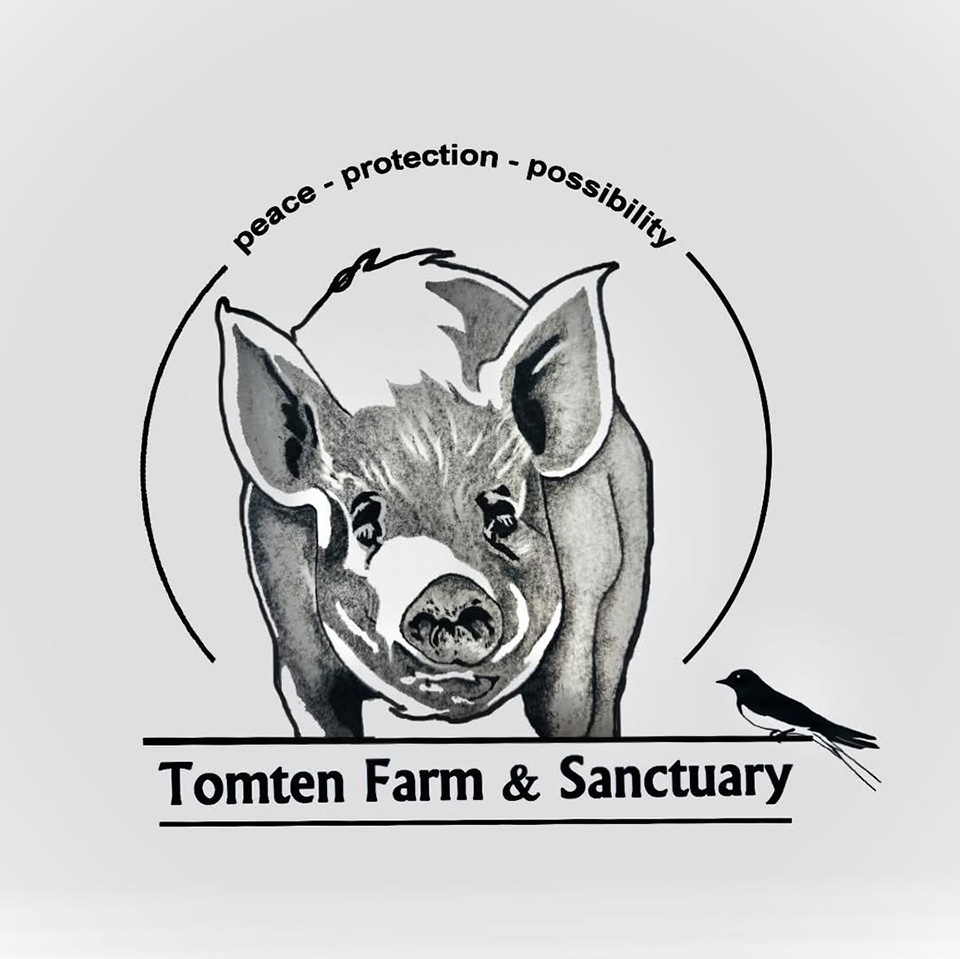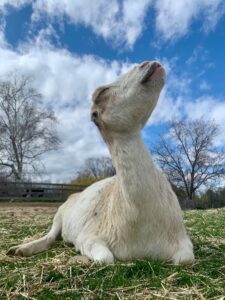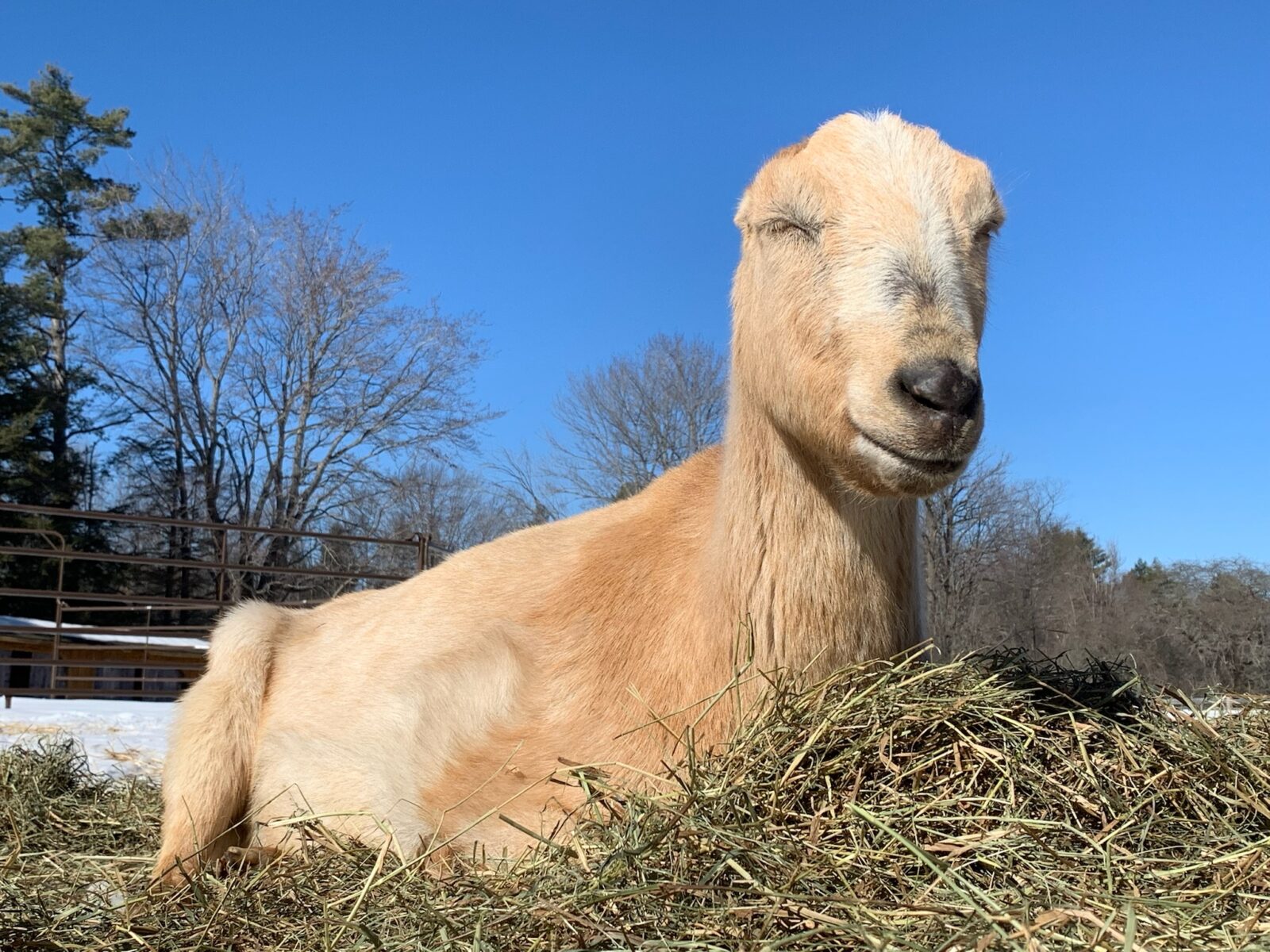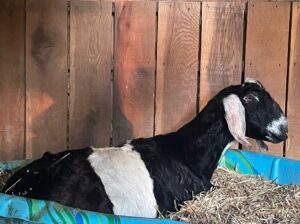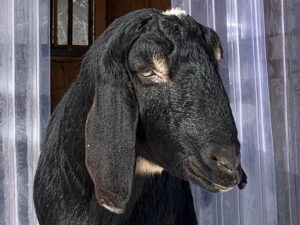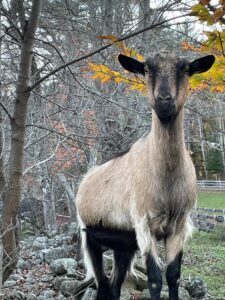Meet the Goats
Click on image to read individual stories.
Meet and Greet. LaLa LaMancha.
Auction is a hard and cruel place and within the hustle and bustle of that one day, there are more reminders to choose kindness than one would ever need in a lifetime. They are the hardest rescues we do.
Picking which goats to rescue from the largest livestock auction in the northeast was no easy task. There were well over 2000 sheep and goats running through the sale that day and simply narrowing them down was an overwhelming project. Purchasing them and saving their lives was even harder. But we made it through and so did these lucky two.
There were all breeds and all ages surrounding us in more pens than I could count, each in desperate need of shelter and the gift of life. They were being sold in groups of bucks and kids and does—all sorted from one pen at a time to others again and again throughout the day until finally ending up in the auction ring and being sold for slaughter based on the number of pounds that popped up on the scale. I do not recall seeing water and the limited hay available did little to reach the majority of lives in the pen. They were hot, they were thirsty, they were tired and they were scared. And some did not even make it through the sale.
It was my first time there and after acclimating ourselves, we quickly realized we must begin our search by seeking the healthiest pens. That in itself was no small feat. From there we looked for the friendliest animals, those that would fit in best at Tomten with volunteers of varying experience, all while trying to get a true lay of the land and the day ahead. There were so many lives and it was so crowded that animals were literally climbing on top of one another and, just like in the stories one hears about these auctions, there was a goat dead in the aisle. And no one seemed to care.
We focused on the task at hand, finding two to take to Tomten Farm and Sanctuary. Disease runs rampant at big sales and so many were already coughing and sneezing. Some had runny noses and others, telling sores. Round and round we went carefully narrowing our choices and at each interval a ginger colored LaMancha would flag us down. Standing, front feet on the old, worn rails, she would call, no, she would scream, to us every time we walked near. There was no doubt she knew she was screaming for her life.
Choosing who to rescue was, as it always is, an incredibly emotional task but this goat, she truly chose us. Each time we passed, she made a point of calling out and always, she was with her off-white friend. We noticed that there were more than those two in their little herd. The two does were with four little kids and a buck and they were trying desperately to stay together as they were constantly moved and separated from one another, first by the sea of lives around them and then, when we had stepped away for just a moment, the auction house staff itself.
Such are the sad and devastating ways of livestock auction where during the season we were there, kids are often sold for religious sacrifices and chosen by their gender and the color of their hide. I quickly realized that whatever it took, we could not leave this Mama doe again, things moved so fast and we were so unfamiliar with this sale, we thought we might lose her and her friend too. So I settled in, following them from pen to pen.
At the time, we had Rastus the Fastest (a large and much loved Nubian wether) and a much smaller farm property. Unfortunately, although we were very tempted, we knew we could not take the buck but he is in our memories, even today. Saying “no” is the hardest word of all and despite the joy of saves, there is always heartache from those whom we lost, the lives we leave behind. We tried our best to find the kids who had been suckling on the does in the pen but to no avail, it seemed. Despite having a pen of kids in the rear, many were running loose having sneaked through the boards and their panicked "baaaas" pulled our heartstrings as we knew not even one would make it to safety. It was a sad, sad thing to spend the day at sale.
I stayed with the does, chatting with the workers and trying to figure out the process so we could just get the two. It was eight years ago and I was very new at this, barely knowledgeable enough to know where to go and to know that my emotions had to stay in check. Hours later, after following them from pen to pen and practically begging the men to run them through alone so we could bid, they thankfully ran through alone, our two does. Scared, exhausted, with bags full of milk and no kids at their side we lifted our card and bid. I suspect we overpaid according to the price per pound that flashed on the screen, but it did not matter as one cannot assign a value to a life.
We backed up our trailer and went to load them. The pens were all but empty then and we found them lying down alone, exhausted. We loaded our tired, grieving goats on the trailer. They had bags full of milk but no kids to nurse. There was no buck at their side but they were together, two friends and we breathed a sigh of relief that they had made it out alive.
Nana, the ginger LaMancha got so sick a week after sale that she barely made it through quarantine. She had a meningeal worm infection and it took many months for her to regain her balance and health to become the goat she is today. She is a true survivor. I remember when we received their negative lab tests for Cae, CL, and Johnes, even our vet seemed surprised. To quote her, "We are very, very lucky.” And we sure were. And we sure are.
We do not know exactly how old Nana Lamancha or her white friend LaLa LaMancha are in years but their souls are old and wise and kind. They were rescued in 2014 and as time passes we hold tight to every day they are with us. Named after my grandmother who once raised dairy goats, Nana embraces everyone she meets without hesitation and welcomes them to the farm. She is still full of life and vigor and greets each day with the same determination to make it count as she did when we first saw her. LaLa, who always appears as though she has just reapplied her lipstick is still the more reserved of the two. Still the steady sidekick, quiet, gentle, and sweet, she takes each day for what it is, a wonderful gift and the energy she shares is nothing less than lovely, grateful and beautiful.
When you support Tomten, you save lives like Nana and LaLa, you help us share their stories and raise awareness for others like like them. Perhaps they are mother and daughter, perhaps simply best friends but either way they share a special bond and we love that they are still together thriving in the embrace of peace, protection and possibility. Thank you for gifting them the lifelong friendship every animal deserves. Together we make their dreams come true.
LaLa LaMancha
Meet and Greet. Nana LaMancha.
Auction is a hard and cruel place and within the hustle and bustle of that one day, there are more reminders to choose kindness than one would ever need in a lifetime. They are the hardest rescues we do.
Picking which goats to rescue from the largest livestock auction in the northeast was no easy task. There were well over 2000 sheep and goats running through the sale that day and simply narrowing them down was an overwhelming project. Purchasing them and saving their lives was even harder. But we made it through and so did these lucky two.
There were all breeds and all ages surrounding us in more pens than I could count, each in desperate need of shelter and the gift of life. They were being sold in groups of bucks and kids and does—all sorted from one pen at a time to others again and again throughout the day until finally ending up in the auction ring and being sold for slaughter based on the number of pounds that popped up on the scale. I do not recall seeing water and the limited hay available did little to reach the majority of lives in the pen. They were hot, they were thirsty, they were tired and they were scared. And some did not even make it through the sale.
It was my first time there and after acclimating ourselves, we quickly realized we must begin our search by seeking the healthiest pens. That in itself was no small feat. From there we looked for the friendliest animals, those that would fit in best at Tomten with volunteers of varying experience, all while trying to get a true lay of the land and the day ahead. There were so many lives and it was so crowded that animals were literally climbing on top of one another and, just like in the stories one hears about these auctions, there was a goat dead in the aisle. And no one seemed to care.
We focused on the task at hand, finding two to take to Tomten Farm and Sanctuary. Disease runs rampant at big sales and so many were already coughing and sneezing. Some had runny noses and others, telling sores. Round and round we went carefully narrowing our choices and at each interval a ginger colored LaMancha would flag us down. Standing, front feet on the old, worn rails, she would call, no, she would scream, to us every time we walked near. There was no doubt she knew she was screaming for her life.
Choosing who to rescue was, as it always is, an incredibly emotional task but this goat, she truly chose us. Each time we passed, she made a point of calling out and always, she was with her off-white friend. We noticed that there were more than those two in their little herd. The two does were with four little kids and a buck and they were trying desperately to stay together as they were constantly moved and separated from one another, first by the sea of lives around them and then, when we had stepped away for just a moment, the auction house staff itself.
Such are the sad and devastating ways of livestock auction where during the season we were there, kids are often sold for religious sacrifices and chosen by their gender and the color of their hide. I quickly realized that whatever it took, we could not leave this Mama doe again, things moved so fast and we were so unfamiliar with this sale, we thought we might lose her and her friend too. So I settled in, following them from pen to pen.
At the time, we had Rastus the Fastest (a large and much loved Nubian wether) and a much smaller farm property. Unfortunately, although we were very tempted, we knew we could not take the buck but he is in our memories, even today. Saying “no” is the hardest word of all and despite the joy of saves, there is always heartache from those whom we lost, the lives we leave behind. We tried our best to find the kids who had been suckling on the does in the pen but to no avail, it seemed. Despite having a pen of kids in the rear, many were running loose having sneaked through the boards and their panicked "baaaas" pulled our heartstrings as we knew not even one would make it to safety. It was a sad, sad thing to spend the day at sale.
I stayed with the does, chatting with the workers and trying to figure out the process so we could just get the two. It was eight years ago and I was very new at this, barely knowledgeable enough to know where to go and to know that my emotions had to stay in check. Hours later, after following them from pen to pen and practically begging the men to run them through alone so we could bid, they thankfully ran through alone, our two does. Scared, exhausted, with bags full of milk and no kids at their side we lifted our card and bid. I suspect we overpaid according to the price per pound that flashed on the screen, but it did not matter as one cannot assign a value to a life.
We backed up our trailer and went to load them. The pens were all but empty then and we found them lying down alone, exhausted. We loaded our tired, grieving goats on the trailer. They had bags full of milk but no kids to nurse. There was no buck at their side but they were together, two friends and we breathed a sigh of relief that they had made it out alive.
Nana, the ginger LaMancha got so sick a week after sale that she barely made it through quarantine. She had a meningeal worm infection and it took many months for her to regain her balance and health to become the goat she is today. She is a true survivor. I remember when we received their negative lab tests for Cae, CL, and Johnes, even our vet seemed surprised. To quote her, "We are very, very lucky.” And we sure were. And we sure are.
We do not know exactly how old Nana Lamancha or her white friend LaLa LaMancha are in years but their souls are old and wise and kind. They were rescued in 2014 and as time passes we hold tight to every day they are with us. Named after my grandmother who once raised dairy goats, Nana embraces everyone she meets without hesitation and welcomes them to the farm. She is still full of life and vigor and greets each day with the same determination to make it count as she did when we first saw her. LaLa, who always appears as though she has just reapplied her lipstick is still the more reserved of the two. Still the steady sidekick, quiet, gentle, and sweet, she takes each day for what it is, a wonderful gift and the energy she shares is nothing less than lovely, grateful and beautiful.
When you support Tomten, you save lives like Nana and LaLa, you help us share their stories and raise awareness for others like like them. Perhaps they are mother and daughter, perhaps simply best friends but either way they share a special bond and we love that they are still together thriving in the embrace of peace, protection and possibility. Thank you for gifting them the lifelong friendship every animal deserves. Together we make their dreams come true.
Nana LaMancha
Meet and Greet. Niccolò Nubiano.
Niccolò Nubiano and Norberto Pantalone.
Livestock auctions around the country are full of orphaned goat kids. They scream at you, they climb up the fence, through the fence, they suck your fingers, they grab your clothes and even when you are trying not too, they make you smile. That is until you realize where you are. And just where it is they are going. And you wish you could put every single kid in the car and take them all home.
There are few things cuter than a baby goat and at auction the goat kid numbers are usually out of control especially in late Winter and early Spring. Most of them, in reality pretty much all, have no future to speak of and it is truly heartbreaking.
A staple in the Mediterranean, Caribbean, South Asia, the Middle East and more, approximately 60-75% of the world's population eats goat meat. But unless you are familiar with certain ethnic and faith-based groups' diets, many people don’t associate goats with meat. Goat meat is called either "cabrito" (meat from kids harvested within the first week of birth) or chevon (meat from older kids). Here in the United States, its popularity is growing in leaps and bounds and, while it might take a bit of shopping around, it is and considered a specialty by many.
Slaughter is not the only reason they are purchased from sale, however. Many kids are used for sacrifice and sales of kids, whether meat or dairy breed, are high before many religious holidays.
But why are they there you ask? Just how could baby goats end up at auction? Well, while goat meat might not be mainstream yet, goat cheese definitely is and the price of it is far greater than you may think. The dairy goat industry is no different than the dairy cow industry in that, like all bull calves born at a dairy, the buckling goat kids are also, sadly, considered a by-product.
In order to have goat milk products, females must constantly produce milk and therefore must be repeatedly bred. However, most babies do not stay with their mothers, more often than not they are pulled. There are many reasons a breeder may separate a kid and Mom at birth, in fact for many breeders, early and immediate weaning of bucklings and doelings is the norm. Possible reasons are the mom is a show goat and they don't want the visual wear and tear on her bag, they have too many goats to individually interact with and early pulling and group bottle feeding allows them to easily imprint and socialize, they cannot have kids running with their adult herd, some of the Moms are CAE positive (Caprine arthritis encephalitis is a contagious viral disease of goats. and they do not want to infect goats who may stay in the herd), and quite simply, because it is more profitable if the milk intended for her kids goes to “us”, the consumer, especially if the kids will be shipping to sale.
Some of the unfortunate kids are dispatched immediately, others shipped at a few days after birth and still others at a few weeks or months, with the average goat kid slaughtered between 3 and 5 months of age. Goat kids do not hold much fat until they are more than a year and for most farmers, the cost of raising them is often more than the profit they will tend so they find themselves en route to slaughter at a very early age. A lucky few of the female kids are destined to become replacement breeding and milking does and some breeders do their best to sell bucklings as pets so some have a better chance to escape slaughter. The 2022 price for such babies is $10 or less. Sadly, however, there are often more kids than available spots in each herd or available homes. Males are essentially considered a waste product and the majority of all goat kids (regardless of gender) end up at auction and slaughter.
Niccolò and Norberto were two of the lucky ones. They almost lost their lives before they were even close to two months old when they found themselves in a pen full of kids awaiting sale, all crying out "maaaaaaaaaa, maaaaaaaa." While we had not intended to get goats that day, we just could not leave them there. Thanks to the dedication of Laima and Aileen, these two, later named Niccolò Nubiano and Norberto Pantalòne, came with us and remained with Laima and Aileen in foster care to be bottle-fed throughout their quarantine period. Auction is a risky place for animals in general; they are exposed not only to unhealthy animals but to many diseases such as Caseous Lymphadenitis (CL) that can survive in the soil and surfaces they come in contact with and we count our blessings that our two little kids made it through ok.
Saving goaties as young as them is always touch and go and, we were not sure they would make it. They were so small and so exhausted that I remember calling our vet and stopping for Gatorade on the ride "home" hoping it would give them a boost until we got there and could provide adequate care. But here they are, six years later, together and safe for the rest of their days. We cannot prove they are siblings but their physical similarities, their seemingly identical age, the fact that they both had already been disbudded (dehorned) and that they stood, huddled together that day in a pen of many, leads us to believe it is so.
Norberto has flourished and as he did from the beginning and he continues to care for and look over his brother/companion Niccolò. Always the frailer of the two, Niccolò, has never fully come into the same vibrant health of his brother, but he is happy and cared for, living in peace, protection and possibility.
Niccolò Nubiano
Meet and Greet. Norberto Pantalone.
Livestock auctions around the country are full of orphaned goat kids. They scream at you, they climb up the fence, through the fence, they suck your fingers, they grab your clothes and even when you are trying not too, they make you smile. That is until you realize where you are. And just where it is they are going. And you wish you could put every single kid in the car and take them all home.
There are few things cuter than a baby goat and at auction the goat kid numbers are usually out of control especially in late Winter and early Spring. Most of them, in reality pretty much all, have no future to speak of and it is truly heartbreaking.
A staple in the Mediterranean, Caribbean, South Asia, the Middle East and more, approximately 60-75% of the world's population eats goat meat. But unless you are familiar with certain ethnic and faith-based groups' diets, many people don’t associate goats with meat. Goat meat is called either "cabrito" (meat from kids harvested within the first week of birth) or chevon (meat from older kids). Here in the United States, its popularity is growing in leaps and bounds and, while it might take a bit of shopping around, it is and considered a specialty by many.
Slaughter is not the only reason they are purchased from sale, however. Many kids are used for sacrifice and sales of kids, whether meat or dairy breed, are high before many religious holidays.
But why are they there you ask? Just how could baby goats end up at auction? Well, while goat meat might not be mainstream yet, goat cheese definitely is and the price of it is far greater than you may think. The dairy goat industry is no different than the dairy cow industry in that, like all bull calves born at a dairy, the buckling goat kids are also, sadly, considered a by-product.
In order to have goat milk products, females must constantly produce milk and therefore must be repeatedly bred. However, most babies do not stay with their mothers, more often than not they are pulled. There are many reasons a breeder may separate a kid and Mom at birth, in fact for many breeders, early and immediate weaning of bucklings and doelings is the norm. Possible reasons are the mom is a show goat and they don't want the visual wear and tear on her bag, they have too many goats to individually interact with and early pulling and group bottle feeding allows them to easily imprint and socialize, they cannot have kids running with their adult herd, some of the Moms are CAE positive (Caprine arthritis encephalitis is a contagious viral disease of goats. and they do not want to infect goats who may stay in the herd), and quite simply, because it is more profitable if the milk intended for her kids goes to “us”, the consumer, especially if the kids will be shipping to sale.
Some of the unfortunate kids are dispatched immediately, others shipped at a few days after birth and still others at a few weeks or months, with the average goat kid slaughtered between 3 and 5 months of age. Goat kids do not hold much fat until they are more than a year and for most farmers, the cost of raising them is often more than the profit they will tend so they find themselves en route to slaughter at a very early age. A lucky few of the female kids are destined to become replacement breeding and milking does and some breeders do their best to sell bucklings as pets so some have a better chance to escape slaughter. The 2022 price for such babies is $10 or less. Sadly, however, there are often more kids than available spots in each herd or available homes. Males are essentially considered a waste product and the majority of all goat kids (regardless of gender) end up at auction and slaughter.
Niccolò and Norberto were two of the lucky ones. They almost lost their lives before they were even close to two months old when they found themselves in a pen full of kids awaiting sale, all crying out "maaaaaaaaaa, maaaaaaaa." While we had not intended to get goats that day, we just could not leave them there. Thanks to the dedication of Laima and Aileen, these two, later named Niccolò Nubiano and Norberto Pantalòne, came with us and remained with Laima and Aileen in foster care to be bottle-fed throughout their quarantine period. Auction is a risky place for animals in general; they are exposed not only to unhealthy animals but to many diseases such as Caseous Lymphadenitis (CL) that can survive in the soil and surfaces they come in contact with and we count our blessings that our two little kids made it through ok.
Saving goaties as young as them is always touch and go and, we were not sure they would make it. They were so small and so exhausted that I remember calling our vet and stopping for Gatorade on the ride "home" hoping it would give them a boost until we got there and could provide adequate care. But here they are, six years later, together and safe for the rest of their days. We cannot prove they are siblings but their physical similarities, their seemingly identical age, the fact that they both had already been disbudded (dehorned) and that they stood, huddled together that day in a pen of many, leads us to believe it is so.
Norberto has flourished and as he did from the beginning and he continues to care for and look over his brother/companion Niccolò. Always the frailer of the two, Niccolò, has never fully come into the same vibrant health of his brother, but he is happy and cared for, living in peace, protection and possibility.
Norberto Pantalone
Meet and Greet. Bernadette Blackbeard.
Welcomed to Tomten Farm and Sanctuary just last year, this beautiful Alpine came into the world in November of 2022 and, as fate would have it, she opened her eyes at one of the private goat dairies right here in New England.
While born into a life of dairy production to meet consumer demand, her home was, thankfully, a far cry from a factory farm. While it is not a "forever" home, the goats at her birthplace have plenty of access to pasture, grazing and browsing with the sun on their backs and the earth underfoot, all while in the company of other caprines.
Yes, Bernadette is one of the more fortunate ones. But despite the quality of care and the personal attention from the owners who provide for each animal 365 days a year, the farm she came from is still a commercial dairy. It is still a business and every life within is still considered a "production animal." Translation: individuals who will never be valued simply for their gifts, their beauty and their personalities. While provided for, they are not pets and their value (and home) is directly linked to their ability to breed, produce milk and meet consumer demand for products like goat milk, cheese, yogurt and more.
As with the dairy cows we have saved, should the lives who live there not be able to contribute at a level that creates a profit, they are considered disposable. Every farmer needs a return on investment and very, very few can ever afford to support the many lives who have supported them no matter how fond they may be of particular animals. It is a tough business (especially here in the northeast), full of tough choices, nonstop work and the kind of ethical dilemmas that I cannot imagine facing. They are the people behind the scenes who meet the consumer demand.
Even on the few, beautiful New England farms left, the dairy industry is still the dairy industry, whether you are talking about cows or goats. In both cases, females must be bred to produce milk. Their kids are taken off them (away) immediately after birth. The doelings are either sold or raised to join the herd and eventually replace their Moms. Bucklings are sold as pets (the few lucky ones) or picked up by the buck buyer where they will be delivered to auction at just days old and shipped to slaughter or depending on the time of year purchased for ethnic holiday and sacrifice. Kids are not the only ones at risk however; older does or any doe that is not a high producer can find herself at risk of an early ship date.
As for our newest goat? What is her story? Well, despite repeated dates with a buck, this beautiful doe did not become pregnant and without a bun in the oven, there would be no kid(s) born, and therefore no milk production. With no private home stepping forward this friendly youngster was sadly, slated to go. The farm who owned her always does their best to place healthy goats in private homes whenever possible but for a large percentage, it just does not work out. As you can imagine, though goats make wonderful pets, there are never enough homes to go around (especially for barren does) and inevitably, goats like her ship to sale and slaughter. Bernadette is one of the lucky ones!
When we said "yes" to her, we had actually tried to step up and welcome two does who were set to be shipped, even paying for the blood tests needed to ensure we could safely welcome both to our clean herd but unfortunately the second goat tested positive for one of three tests that would put those we have already rescued at risk. To protect the lives already here at Tomten, sadly we could not say "yes" to Bernadette's friend, such is one of our heartbreaks of responsible rescue. While we are deeply disappointed that we were unable to save the other doe, we hope Bernadette Blackbeard will be an ambassador for others like her, raising awareness, sharing knowledge and making an impact on all who meet her both personally and virtually.
While she may be the newest rescue goat at Tomten, she has happily settled in with the confidence that this will be her forever home and spends her days with our other goats (and sheep) eating, sunbathing and when the season allows, adventuring through the farm and browsing on the many leafy treats.
We are very grateful to the dairy farmer for holding them while we awaited results from the vet. It was a gift that we would not have received had we rescued from auction or, frankly, from some other sources. We are fortunate and our doe is fortunate that they chose to work with us so amicably. Proof once again, that while we come from different sides of the road, we are both human and basic courtesy means it does not have to be us against them. Kindness and goodwill beats discord and conflict every time and often it is the life we save who benefits and the people who learn her story.
Being more, doing more and giving more takes place with even the simplest changes in our lifestyle and your efforts make a tremendous difference to lives like this doe and to lives like that of her friend who sadly slipped through the cracks. Please continue choosing kindness, for most folks this journey is a process. Someday, one day, we hope that kindness and compassion will lead the way for all.
Thank you for being here beside us and helping us help her find her way to peace, protection and possibility. Together we are Tomten Farm and Sanctuary.
Bernadette Blackbeard
Facts about Goats
Coming soon...
